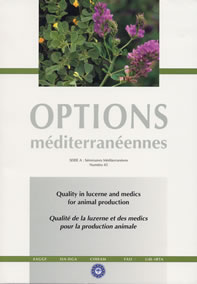| Article précédent | p. 145-151 | Article suivant |
Adaptation of legumes to multiple stresses in Mediterranean-type environments
Humid and mild winter and hot and dry summer characterize the areas with Mediterranean climate. Plants developing in such climates are periodically subjected to a combination of stresses including not only the lack of water and high temperature coupled to high evaporative demand and high light intensity in summer but also limitation in nitrogen content, phosphorus and other nutrients in the soil. Cold winter is also relevant in some areas. This situation is sometimes aggravated by salinity, fire, overgrazing, etc. The culture of forage legumes adapted to a wide range of soil types, climate conditions and management systems will contribute to increase soil fertility and to maintain soil structure in such environments. In this article, the behaviour of different legumes adapted to Mediterranean climate is discussed. Physiological aspects of the symbiosis Rhizobium-legume-arbuscular mycorrhizae are analysed in relation to adaptive responses to relative humidity, water stress, nutrient availability and atmospheric carbon dioxide enrichment.
- [ Afficher ]
- [ Télécharger ]
- [ Exporter la citation ]
Vous pouvez télécharger la citation au format :
- [ Imprimer ]
-
Mots-clés
CLIMAT MEDITERRANEEN, ENRICHISSEMENT EN GAZ CARBONIQUE, LUZERNE, MYCORHIZE, RHIZOBIUM, STRESS DU A LA SECHERESSECiter cet article
Sánchez-Díaz M. Adaptation of legumes to multiple stresses in Mediterranean-type environments. In : Delgado I. (ed.), Lloveras J. (ed.). Quality in lucerne and medics for animal production . Zaragoza : CIHEAM, 2001. p. 145-151. (Options Méditerranéennes : Série A. Séminaires Méditerranéens; n. 45). 14. Réunion Eucarpia du Groupe Medicago spp., 2001/09/12-15, Zaragoza and Lleida (Spain). http://om.ciheam.org/om/pdf/a45/01600074.pdf



